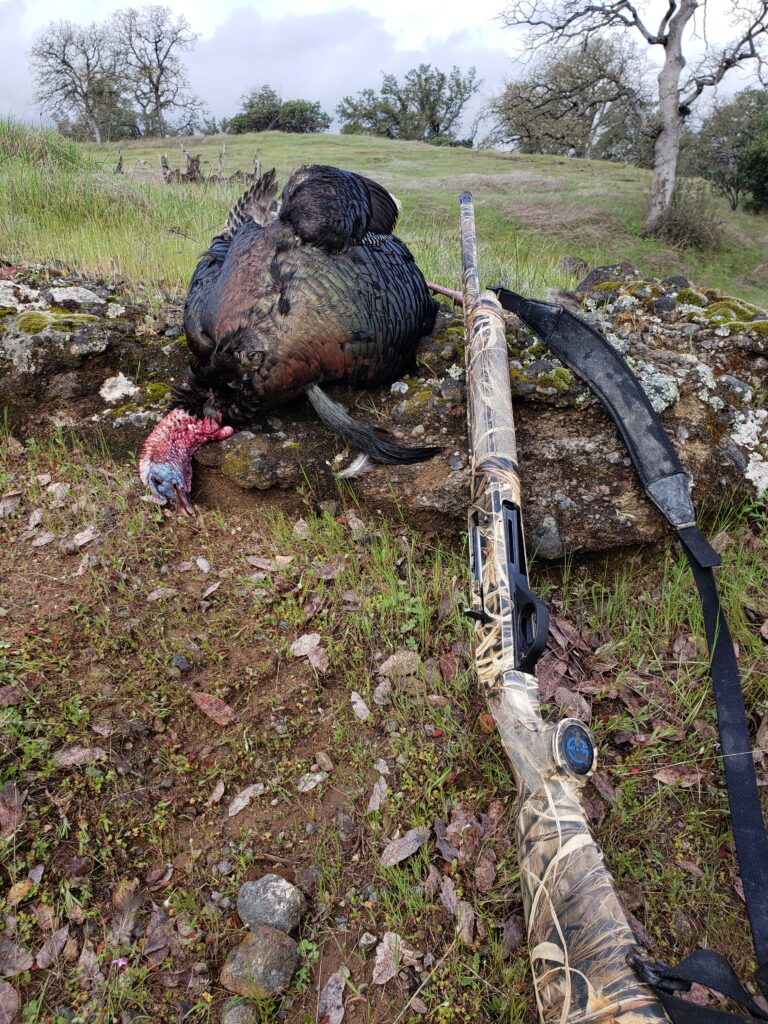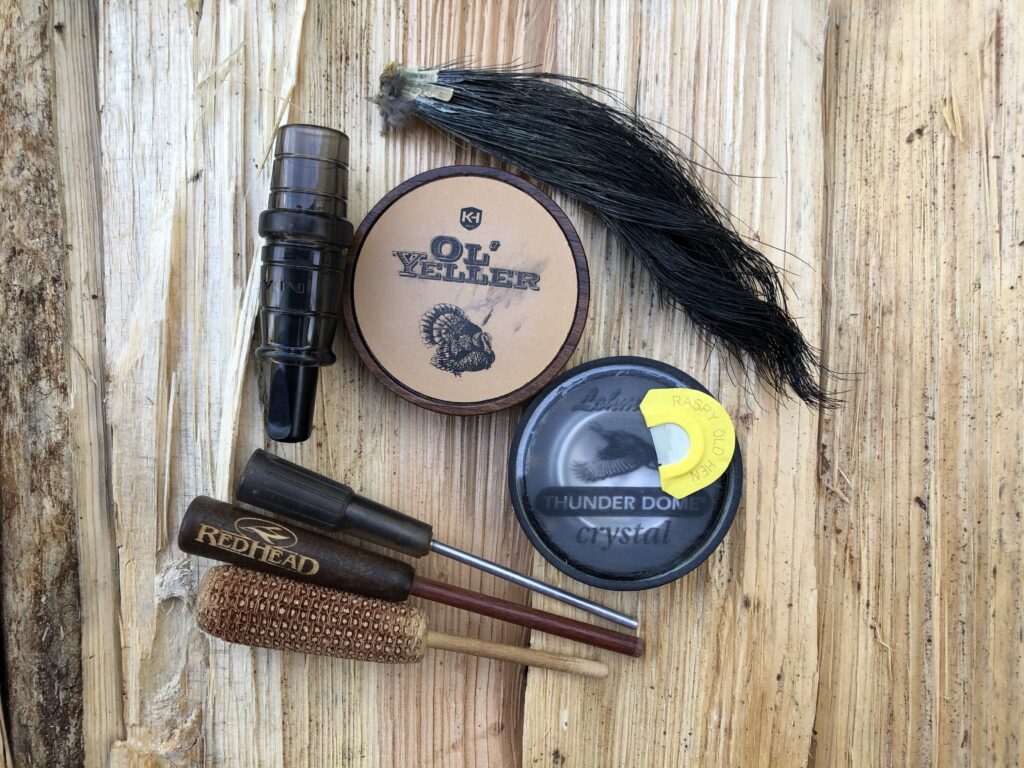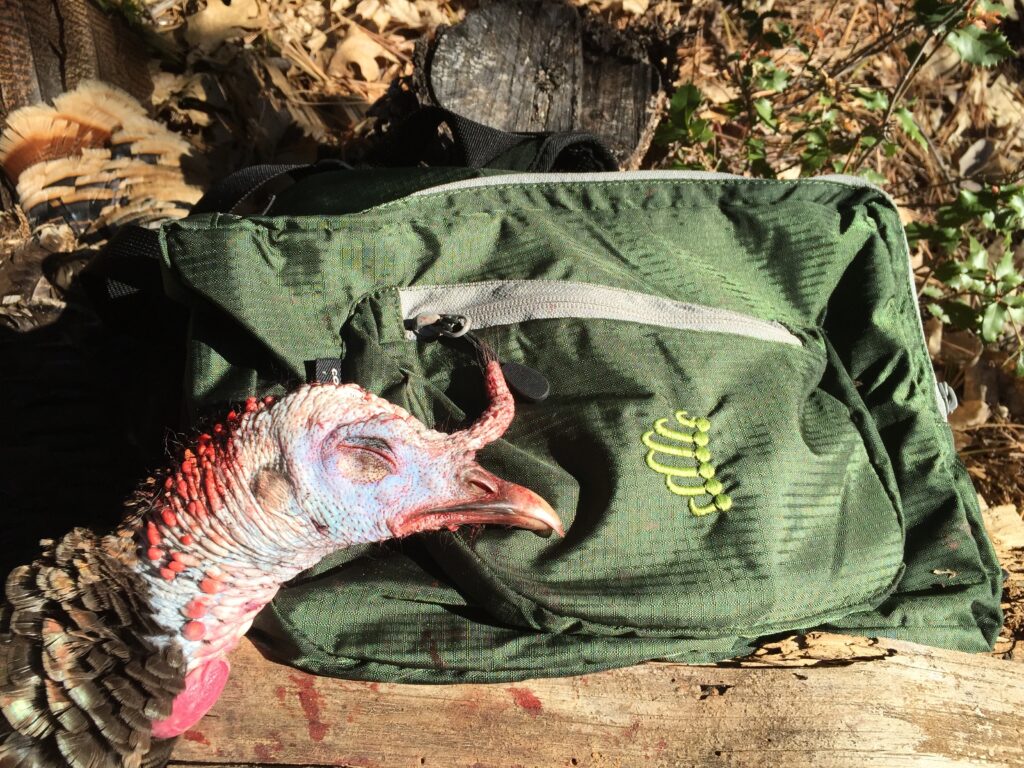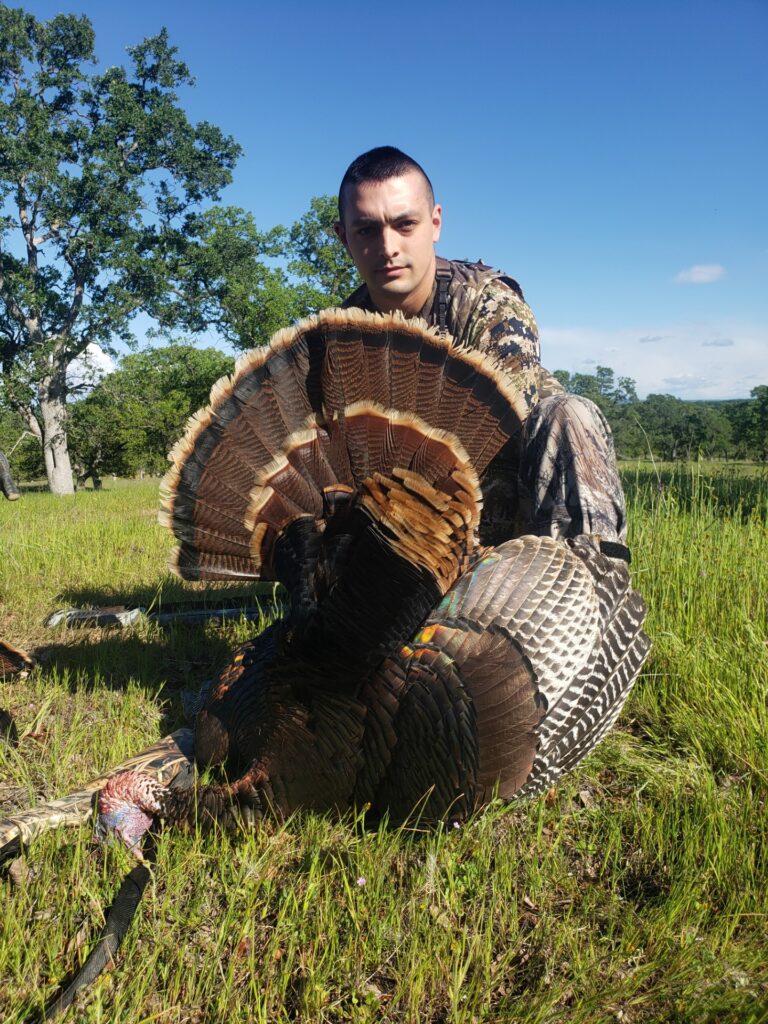Spring Turkey Time Is Here! How To Score Public-Land Gobblers
The following appears in the March issue of California Sportsman:

Longbeards are plentiful on public land in the Golden State, but to score you’ve got to think outside the box. A drift boat was utilized to gain access to the Sacramento River wildlife area where this fine turkey was harvested. California’s spring season opens on March 30. (ALL RIVER FISHING GUIDE SERVICE)
By Cal Kellogg
Killing public-land gobblers in California and elsewhere is easy, or perhaps I should say, easy with a little bit of knowledge. For me, it took roughly 20 years of field experience chasing spring gobblers to get to the point where I was consistently harvesting them. Luckily for you, I’m going to pass along some of the most fundamental rules and field tactics I’ve established for bagging heavily pressured public-land toms.
Whether you are new to turkey hunting or have a few spring seasons under your belt but are looking to increase your success rate, the first thing I want you to do is forget just about everything you’ve gleaned from watching television hunting shows and videos created by prominent celebrity hunters.
Am I saying the shows don’t provide useful information or are in some way fake? Absolutely not, but the thing you’ve got to realize is that most of the instructional turkey hunting videos you see on television or on YouTube are filmed on private property, where the birds are subjected to little hunting pressure.
This lack of pressure makes a huge difference in the way you approach the hunt. Private-land birds likely haven’t been spooked or exposed to calling, and you don’t have to worry about another hunter stumbling into your setup.
Unfortunately, you likely don’t have access to a sweet private-land hunting spot for this spring’s season – opening on Saturday, March 30 – so you’re going to be hunting a wildlife area or on national forest land. The birds you encounter are going to be pressured and you’ll be competing against other hunters, so you’ll have to develop tactics to successfully deal with the challenging public-land hunting scene. Let’s dive in!


SCOUTING
Every turkey hunting article you read stresses the importance of scouting, and scouting is indeed an important part of the equation. But if you don’t live near the turkey woods, how realistic is it for you to work in extensive scouting between responsibilities at home and work?
I’m going to assume that if you’re reading this, you’ve identified some areas that hold turkeys but haven’t had the time to pattern any birds before the season.
These days, a lot of preliminary scouting can be done with a computer to identify areas that might offer opportunity to the weekend warrior or the hunter who can take a few vacation days in the spring to hunt during the week.
AVOIDING OTHER HUNTERS
Nothing can shut down a turkey hunt faster than big numbers of hunters roaming around, calling too much and/or calling too loudly. The more famous or renowned the hunting area, the more pressure it will attract, especially on the opening weekend of the season.
For example, I used to have tremendous success hunting the Auburn Recreation Area, but the word has gotten out and the area attracts hordes of hunters on the opening weekend of season. I still hunt the area occasionally, but never during the first week of the spring season.
This brings us to my first rule on public land: If you don’t have a gobbler pinpointed prior to the opener, don’t go hunting on the opening weekend of the season. The spring turkey season is long and if you don’t have a hot prospect, your time is better spent hunting later.
I’d estimate upwards of 90 percent of casual turkey hunters hit the woods on the opener looking to score an easy bird and then never hunt again the rest of the season.
These hunters will kill some jakes and a few overly enthusiastic gobblers, but they will give the remaining, less vocal gobblers an education that will influence how you must hunt them for the rest of the season and beyond.
Beyond not hunting on the opener, another way to avoid the crowds is to work areas not widely known to hold birds. Most hunters on public land are drawn to the grassy oak-dotted expanses of the foothills. The foothills hold a lot of turkeys, hiking is easy and visibility is good. As a result in California, public land in the foothills draws the lion’s share of the hunting pressure in the spring.
Rather than focusing on areas where I know the pressure will be extreme, I’ve been doing a lot of hunting in higher-elevation areas not traditionally considered turkey country. California’s turkey population is always evolving and expanding. I’d rather hunt a high elevation with a small population of turkeys and no hunters than an area with big numbers of birds and lots of pressure.
I’m also always on the lookout for new ground. I recently saw a friend of mine who lives in a high desert area of California and who was lamenting about the damage turkeys were doing to her yard. She lives in an area where I didn’t think any turkeys existed.
I reached out to her, and she sent me a cell phone photo of three big gobblers standing in her driveway. She related the first birds had shown up about three years ago. Guess where I’m headed this spring?

CALLS, CALLING STRATEGY AND DECOYS
I used to be the guy with a dozen different turkey calls in my vest. Over time it became six and now three. When it comes to calling gobblers on public land, less is more. These days I carry a plexiglass friction call, a ceramic friction call and a couple diaphragm calls.
The plexiglass call, combined with a wooden striker, is my favorite call. I use the ceramic teamed with either a metal or carbon fiber rod for windy days because of the high-pitched sounds I can make with it.
In terms of the diaphragms, I stay away from the models with three and four reeds and complex cuts and notches. I typically go with a dual diaphragm call. Diaphragms like this are easy to master and allow me to make sweet, low-volume yelps.
I typically start the calling sequence to a gobbler using a friction call. Once he answers me, I know he’s pinpointed my location. At this point I go into stealth mode. I set the friction call down, ready my gun or bow and switch to the diaphragm, because I can use it while remaining rock-steady still.
Never ever use turkey noises to locate a gobbler. Furthermore, it’s time to clam up once you set up on a bird and he responds to your hen noises. Because he knows exactly where you are, there is nothing to gain by making him sound off again and again. Those gobbles while he’s coming in could attract another hunter and sabotage all your hard work.
When you’re out looking for a turkey, you’ll need something other than turkey sounds to make a turkey shock gobble. You need something that will make him sound off without causing him to move in your direction.
These days, I rely on a crow call and a redtail hawk screamer to illicit shock gobbles. For a long time, I used a silent dog whistle; not the cheap kind you get out of a gumball machine, but a real one machine d out of brass. It cost me about $35 and I ended up losing it. I’ll probably pick up another one someday because it worked so well.
Once you make a bird sound off with a shock call, it’s time to move in on it as quickly and as quietly as possible. Try to set up above the bird in an area of broken cover. Once I’m at my setup spot, I’ll often fire off the crow call again to pinpoint his location one last time.
Remember that gobblers are closer than they sound. Try to move in that extra 25 yards and you may well find out the bird you thought was 200 yards away was actually only 50 yards away when he flies off.
A good setup offers a tree or rock for you to lean against. Calculate where the gobbler is and where you want to shoot him. This is the spot where you set up a single hen decoy. You want it 20 paces from you.
This is far enough for your shot pattern to open up a bit, but not so far that the pattern will get sparse. With a full choke in your turkey gun, it’s possible to miss a turkey’s head at 10 yards because the pattern is so small. I’ve done it.
Here’s how my calling sequence goes once I’m set up: I make two or three solid yelps on the friction call. If the gobbler answers, down goes the call and up goes the gun. If he doesn’t answer, I’ll usually hammer out a four- or five-yelp sequence louder, but typically the bird will answer the first series of yelps.
When Mr. Gobbler answers I assume he’s coming. This is when you must stay motionless and use both your ears and eyes. You may hear the bird’s footsteps. Visually, you’ll usually spot the bird’s bobbing head before you see the body.
Hopefully he spots the decoy and comes right in, but he may not see it. The only time I use the mouth call is if the bird wanders by my position without offering a shot. When this happens, I make a couple very quiet yelps and maybe a purr. Generally, the bird will sound off with a gobble and come back in searching for the hen.
If you get a gobbler to answer you in the morning but he won’t move your way, you can bet money that he’s henned up. Gobblers are reluctant to leave hens to find hens. You can often kill a bird like this later in the day.

HUNTING AFTER THE MORNING BREEDING BLITZ
Early in the season, most respectable gobblers will be running with a band of hens. These birds will gobble their heads off but will seldom move toward you and offer a shot. Turkeys do their breeding early in the day as they forage. Once the morning feeding and breeding is done, the hens head for their nests to lay eggs and tend to the eggs they previously laid.
Gobblers that were surrounded by eight or 10 hens early often find themselves alone in the early afternoon.
If you sparked up a gobbler with hens early, you want to be back in that spot by noon. Plan on sitting there until shooting hours expire at 4. Very often the now lonely gobbler will remember that sexy hen he was talking to earlier and will come looking for her.
You want to be set up in a comfortable spot with good cover with your decoy positioned in front of you. This work calls for light, intermittent yelps and purrs. You can also do some scratching in the leaves with your hand, simulating the sound of birds scratching around and feeding.
The gobbler may sound off as he comes in, but don’t count on it. As likely as not, you’ll just spot his head ghosting through the underbrush a few seconds before he steps into the open and puffs up to impress your decoy.

FINAL NOTES: RAIN, CAMO, HUNTING INTO THE LATER SEASON
A lot of guys don’t like to hunt during the rain, but that’s a mistake. Unless it’s really pouring, the turkeys will behave in a business-as-usual manner when it’s raining; so should you. I’ve killed a lot of turkeys on rainy spring days and can almost guarantee you that if it’s raining, you’ll be the only hunter in the woods!
Camo is an important part of turkey hunting. You want both your face and hands covered, but you don’t need the latest and greatest computer-generated camo duds. I’ve killed a lot of turkeys dressed in green work pants and a beat-up old long- sleeve cotton camo shirt. Again, good setups and remaining still make for the best camo.
As the season drags on into the second half of April, I tend to do less running and gunning and more sitting, waiting and light calling with my decoy deployed. This is the time of the year when you can hit those uber-popular foothill wildlife areas that were overrun with hunters for the first few days of the season.
The gobblers that are still standing after the opener likely won’t be super-vocal birds, and most of them will have pushed onto private property adjacent to the public land. The strategy at this time is to work the public-private border ground.
Some new housing developments have cropped up right next to a wildlife area in my region, and when I’m coming and going, I’ll often drive into the developments to see if turkeys are using the private property as a sanctuary. If they are, I’ll move into position just outside the private land. Often, these birds will roost on the public land and move onto the private land as soon as they hit the ground in the morning.
I killed my heaviest ever gobbler, a monster just under 23 pounds, working a fringe area adjacent to private land. He was henned up and roosting on public land with his girls. They would hit the ground and immediately head for a hobby farm a couple hundred yards away. I set up in their travel corridor a full two hours before dawn.
I set up my hen decoy and wrapped a red bandana around its neck to simulate the look of a gobbler. When Mr. Big spotted that skinny “gobbler” trying to move in on the ladies, he came in on the run. I took him down with a swarm of No. 6 shot and without making any turkey sounds.
Good callers kill some spring gobblers. Hunters employing solid field tactics kill more. Never forget, spring turkey hunting is chess, not checkers! CS
Editor’s note: Cal Kellogg is a longtime Northern California-based outdoors writer. Subscribe to his YouTube channel Fish Hunt Shoot Productions at youtube .com/user/KelloggOutdoors.



